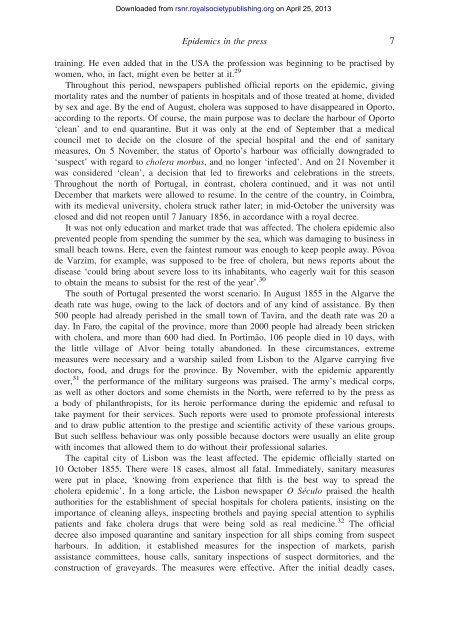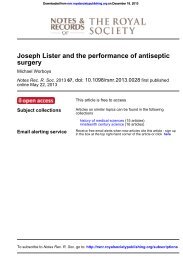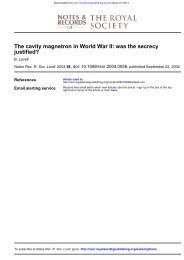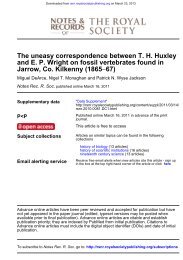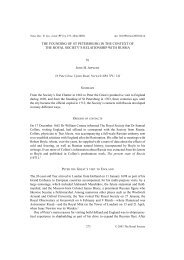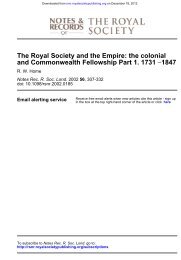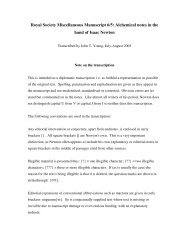THE PORTUGUESE CHOLERA MORBUS EPIDEMIC OF 1853–56 ...
THE PORTUGUESE CHOLERA MORBUS EPIDEMIC OF 1853–56 ...
THE PORTUGUESE CHOLERA MORBUS EPIDEMIC OF 1853–56 ...
Create successful ePaper yourself
Turn your PDF publications into a flip-book with our unique Google optimized e-Paper software.
Downloaded from<br />
rsnr.royalsocietypublishing.org on April 25, 2013<br />
Epidemics in the press 7<br />
training. He even added that in the USA the profession was beginning to be practised by<br />
women, who, in fact, might even be better at it. 29<br />
Throughout this period, newspapers published official reports on the epidemic, giving<br />
mortality rates and the number of patients in hospitals and of those treated at home, divided<br />
by sex and age. By the end of August, cholera was supposed to have disappeared in Oporto,<br />
according to the reports. Of course, the main purpose was to declare the harbour of Oporto<br />
‘clean’ and to end quarantine. But it was only at the end of September that a medical<br />
council met to decide on the closure of the special hospital and the end of sanitary<br />
measures. On 5 November, the status of Oporto’s harbour was officially downgraded to<br />
‘suspect’ with regard to cholera morbus, and no longer ‘infected’. And on 21 November it<br />
was considered ‘clean’, a decision that led to fireworks and celebrations in the streets.<br />
Throughout the north of Portugal, in contrast, cholera continued, and it was not until<br />
December that markets were allowed to resume. In the centre of the country, in Coimbra,<br />
with its medieval university, cholera struck rather later; in mid-October the university was<br />
closed and did not reopen until 7 January 1856, in accordance with a royal decree.<br />
It was not only education and market trade that was affected. The cholera epidemic also<br />
prevented people from spending the summer by the sea, which was damaging to business in<br />
small beach towns. Here, even the faintest rumour was enough to keep people away. Póvoa<br />
de Varzim, for example, was supposed to be free of cholera, but news reports about the<br />
disease ‘could bring about severe loss to its inhabitants, who eagerly wait for this season<br />
to obtain the means to subsist for the rest of the year’. 30<br />
The south of Portugal presented the worst scenario. In August 1855 in the Algarve the<br />
death rate was huge, owing to the lack of doctors and of any kind of assistance. By then<br />
500 people had already perished in the small town of Tavira, and the death rate was 20 a<br />
day. In Faro, the capital of the province, more than 2000 people had already been stricken<br />
with cholera, and more than 600 had died. In Portimão, 106 people died in 10 days, with<br />
the little village of Alvor being totally abandoned. In these circumstances, extreme<br />
measures were necessary and a warship sailed from Lisbon to the Algarve carrying five<br />
doctors, food, and drugs for the province. By November, with the epidemic apparently<br />
over, 31 the performance of the military surgeons was praised. The army’s medical corps,<br />
as well as other doctors and some chemists in the North, were referred to by the press as<br />
a body of philanthropists, for its heroic performance during the epidemic and refusal to<br />
take payment for their services. Such reports were used to promote professional interests<br />
and to draw public attention to the prestige and scientific activity of these various groups.<br />
But such selfless behaviour was only possible because doctors were usually an elite group<br />
with incomes that allowed them to do without their professional salaries.<br />
The capital city of Lisbon was the least affected. The epidemic officially started on<br />
10 October 1855. There were 18 cases, almost all fatal. Immediately, sanitary measures<br />
were put in place, ‘knowing from experience that filth is the best way to spread the<br />
cholera epidemic’. In a long article, the Lisbon newspaper OSéculo praised the health<br />
authorities for the establishment of special hospitals for cholera patients, insisting on the<br />
importance of cleaning alleys, inspecting brothels and paying special attention to syphilis<br />
patients and fake cholera drugs that were being sold as real medicine. 32 The official<br />
decree also imposed quarantine and sanitary inspection for all ships coming from suspect<br />
harbours. In addition, it established measures for the inspection of markets, parish<br />
assistance committees, house calls, sanitary inspections of suspect dormitories, and the<br />
construction of graveyards. The measures were effective. After the initial deadly cases,


